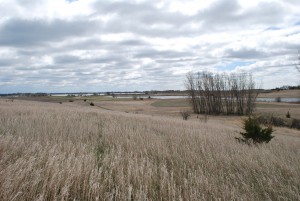
Minnesota Farmer, Carl “Russ” Pilegarrd, has participated in the Conservation Reserve Program from the start. He uses wetland buffers and shelter belts to prevent erosion, improve soil and water quality and promote wildlife habitat.
When the USDA Conservation Reserve Program (CRP) was enacted in December of 1985, Carl “Russ” Pilegaard, a Minnesota farmer knew the program was something he needed to incorporate into his farming operation so he reached out to his local Farm Service Agency (FSA) office.
Pilegaard was one of the first farmers in Minnesota to participate in CRP when, in 1986, he enrolled 108 acres of his farm near Ruthton in Murray County into the program.
“Even though CRP was initially targeted toward highly erodible acres, I was excited about the improvements it could make to my soil, water and wildlife habitat,” said Pilegaard.
CRP, which is celebrating its 30th anniversary in 2015, is among the largest private lands program for conservation used extensively throughout the United States to reduce soil erosion, improve water and air quality and provide wildlife habitat.
It is a voluntary program that allows eligible landowners to receive annual rental payments and cost-share assistance to establish long-term, resource-conserving covers on eligible farmland throughout the duration of their 10-to-15-year contracts.
Through CRP, Pilegaard planted 26 miles of shelterbelts to prevent soil erosion. Shelterbelts, or windbreaks, typically consist of trees or shrubs planted on the edges of cropland creating a natural wind barrier to protect fields, farmsteads and livestock from wind damage. Shelterbelts can also provide vital habitat for wildlife including a food source and cover.
“As the land rests, it builds up tilth and soil structure and sequesters carbon in the root system,” said Pilegaard. “I am down to zero erosion and have built up the soils.”
In addition to controlling erosion, Pilegaard wanted to do more to create and protect wildlife habitat.
“I also planted [riparian] buffers around a 90 acre lake,” said Pilegaard. “We now have a quality place for family and friends to hunt without using public hunting areas.”
Riparian buffers allow landowners to improve water quality while creating habitat for wildlife by planting a strip of trees bordering perennial or seasonal streams, waterbodies and wetland areas. The buffers work to filter nutrients from runoff, trap sediment, cool water temperatures, stabilize stream banks and sequester carbon.
Pilegaard is proof that conservation programs work; he has seen many improvements since the initial enrollment in 1986 and continues to participate in the program with added acres. Today, he has 340 acres enrolled in CRP on farms in Murray and Pipestone counties.
“My goal is to leave the land in better condition than when I bought it and preserve it for my grandchildren to someday farm and make a sustainable living,” said Pilegaard. “Life is impossible without soil to feed and nurture people, plants and animals.”
Since being established on December 23, 1985, CRP has helped prevent more than 8 billion tons of soil from eroding and protected more than 170,000 stream miles with riparian and grass buffers, more than 100,000 acres of bottomland hardwood trees, nearly 300,000 acres of flood-plain wetlands, and 250,000 acres each for duck nesting habitat and upland bird habitat.
2015 marks the 30th Anniversary of CRP. For an interactive tour of CRP success stories from across the U.S., please visit the FSA CRP 30th Anniversary website at http://www.fsa.usda.gov/CRPis30.





